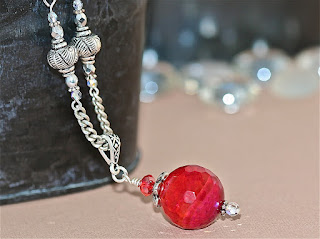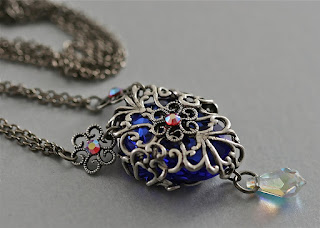My latest obsession has become creating collage pendants. The possibilities are endless, but I particularly enjoy vintage and art nouveau themes.
Making a collage pendant is not difficult, but does require some time and thought. Here is the process I use:
Supplies: Image or photo, pendant frame, E-6000 glue, glaze such as Diamond Glaze. You will also need simple tools such as an Xacto knife - or a paper punch, toothpicks or wooden craft sticks, and waxed paper.
1. First select your pendant shape and style - circle, oval, square, rectangle. Decide on either a simple frame or an ornate one with fancy edging. Since I like vintage style jewelry, one of my favorite places to purchase frames is
VintageJewelrySupplies.com. This site offers good products at reasonable prices and fast free shipping.
2. Next, select your image to fit the frame. You can use wrapping paper, magazine photos, and greeting cards. Or you can purchase collage picture images already sized and shaped for common pendant frames. I purchase many of my images on Etsy where there is a wealth of styles and themes from various sellers.
3. Prepare your image. If you are printing out a collage sheet or other image from your computer, first be sure to use the best quality settings for your printer. I find printing on photo paper works best. Next seal your image to prevent the ink from running and smearing during gluing and glazing later - I use Aleene's spray acrylic sealer which I purchase at Michael's craft store - you can choose either a matte or glossy finish (both work fine.)
4. Cut out your image. If you are "free styling" (not using a pre-sized and shaped" collage sheet) then make a template of your shape by tracing the shape on a piece of paper - preferably thick cardstock type. Then cut out the shape leaving a circle (or whatever shape you're using) opening in the paper. Then you can place the template over your desired image, trace with pencil and cut it out. I usually leave about 1/8 inch around the edge to trim later - this makes for easier handling. Use a craft knife or xacto knife to cut your image - be careful as they are quite sharp!
A quicker easier method for cutting your image is to purchase a paper punch at a craft store such as Michael's. These come in standard 1 and 2 inch circles, ovals, squares and many other shapes. I recommend this method if you are going to be making a number of pendants.
5. Glue your cut out image to the pendant frame. I use E-6000 glue (I purchase from Michael's) placing a small amount on the back of the image and pressing it onto the frame. Use a toothpick or small wooden pointed craft stick to clean off excess around the edges. But if you leave some E-6000 dries clear and excess can be cut off later with your craft knife. E-6000 becomes tacky in 2 minutes and begins to set in 10 minutes - but takes 24 to 72 hours to fully cure. After drying, you can trim the edges of your paper if needed with your Xacto knife - if you used a paper punch, this step is usually unnecessary.
6. Now it is time to apply glaze to seal and protect the image. Be sure to allow the glue from step 5 to dry sufficiently - I usually allow several hours (4 hours or longer.) Although not fully cured yet, this is enough time for proceeding.
I use
Diamond Glaze which can be purchased at various sites on-line. One site I have used is
CreateForLess.com but there are many others - even Ebay where this product can be found.
Applying the glaze is a bit tricky but not overwhelmingly so. Place your pendant on a flat surface where it will be able to sit without being disturbed for at least 24 hours. I use a flat chopping board with waxed paper placed on top for easy clean up.
First squeeze out a small dab of the glaze onto the waxed paper to expel any bubbles. Then without turning the bottle back upright, immediately squeeze the glaze onto your image - I start from the center and work my way outward in a circular motion. If air bubbles develop, pop them with a needle or even your fingernail.
Now let the glaze dry and cure. It will be sufficiently dry to carefully move after 24 hours, but takes 72 hours before fully curing. If not fully cured, you can leave smudges and indentations on your glaze with handling.
7. Now you are ready to place your pendant on a chain or cord and proudly wear!
Here are some collage pendant I recently made and have for sale on Etsy at
DJAjewels.etsy.com:
Victorian Beauty Art Nouveau Pendant: This pendant features an Alphonse Mucha image of a Victorian era woman encircled within an antiqued silver collage pendant. Hangs simply on an antiqued silver chain.
Antiqued Gold Bluebird Pendant : Circle collage pendant featuring a delightful pair of bluebirds tending their nest. Nest has four eggs including one surprise golden egg. Collage image is set into an antiqued brass frame and hangs simply from a 22K antiqued gold plated chain.
Art Nouveau Mucha Pendant : Art Nouveau style pendant featuring an Alphonse Mucha image of a lovely Victorian era woman. Simple yet elegant antiqued brass frame forms a golden halo around the beautiful young woman. Hangs from an antiqued brass chain.


















































